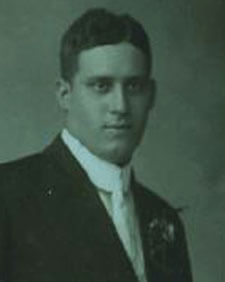
END OF WATCH: March 8, 1933
Cleveland Police Department
Age: 45
On March 6, 1933, Patrolman Herman Pahler was directing traffic in front of St. Mary’s Catholic School on when he was hailed by a truck driver, who spotted Herman Klink approaching with a rifle going down West 38th Street. Immediately Klink fired at Patrolman Pahler, who fell in the middle of the street’s intersection, making the unfortunate officer the third victim of Klink’s shooting spree. Before Klink would finish his scourge, three would die and eight would lie wounded. Patrolman Pahler would die the next day from his injuries.
The weapon Klink used was a 22 caliber high-powered rifle with a maximum range of 2,880 feet. The bullets used were brass jacketed with mushroom noses, usually refered to as “dum dum” bullets. Naturally the damage caused by each bullet would be severe, and not only that, the medical expertise of the time would not be sufficient to save Pahler’s life.
The background on Herman Klink would show a loner with no relatives in this country; and from a psychiatric standpoint he was analyzed as suffering from “dementia praecox”, a persecution complex. It might be well to point out here that supervisors at the company where Klink worked, determined he had reached a dangerous mental state, but no one was able to take the initiative to do something to prevent the explosion of this walking time bomb.
Truthfully, in the fifty-eight years since, our laws and preventative steps have improved very little as can be seen by the McDonald’s restaurant massacre or the shooting at the Texas University Tower. It should be further emphasized at this point that the bullets fired by Klink also endangered the lives of the children being directed by Pahler.
William Wingate braved rifle fire to drag Officer Pahler to his car and rush him to the hospital. It may be that in Officer Pahler’s death, this story of heroism retains its true importance: here unquestionably a citizen acts, at the possible cost of his life, in order to aid an officer.
This story should be emblazoned daily on the minds of citizens at a time now when the attitude has so commonly become to stay out of it. This story is truly one of tragedy for all concerned, but it points out that in the end we must all live one day at a time, trusting in God and our abilities. As a police officer we never know the clear blue day that can become our moment of truth or our epitaph.
In memoriam to Officer Herman Pahler, who was 45 years old when he passed to his reward on March 8, 1933, we might very simply, with a hand salute to his valor, say he died in the line of duty.
Herman Pahler’s name is inscribed on the National Law Enforcement Officers Memorial Wall in Washington D.C. Panel 5, E -10
Note: Author, Robert Clark was killed in the line of duty in 1998.
By Recruit Robert Clark, Cleveland Police Academy